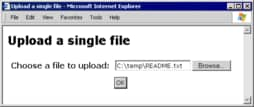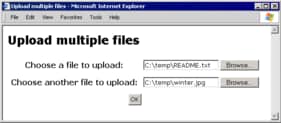Uploading Files
Overview of Uploading Files
You can
use the SAS Stored Process Web Application to upload one or more files
to your SAS Stored Process Server. The upload process is initiated
by a custom input form that contains an INPUT tag with the attribute
TYPE set to
file:<input type="file" name="myfile">
This tag enables you
to specify the file that you want to upload. For more information, see Specifying Custom Input Forms. After the
form data is submitted, the file that you chose and any other name/value
pairs that are contained in the custom input form are sent to the
stored process server. Your stored process can then use both the name/value
pairs and the file that was uploaded.
Reserved Macro Variables
The reserved SAS macro variables that are associated
with uploading files all start with
_WEBIN_.
specifies the number
of files that were uploaded. If no files were uploaded, then the value
of this variable is set to zero.
specifies the SAS fileref
that is automatically assigned to the uploaded file. You can use this
fileref to access the file. The uploaded file is stored in a temporary
location on the stored process server, and is deleted when the request
is completed. Be sure to copy the file to a permanent location if
you need to access it at a later date.
specifies a unique
name for the SAS table, view, or catalog that was uploaded. A value
is set for this macro variable only if a SAS table, view, or catalog
was uploaded. All SAS data types are stored in the Work library. The
type of SAS file that was uploaded is stored in the _WEBIN_SASTYPE
macro variable. See also _WEBIN_SASNAME_ORI.
specifies the original
name of the SAS table, view, or catalog that was uploaded. If a SAS
table named
mydata.sas7bdat was uploaded,
then _WEBIN_SASNAME_ORI contains the value mydata. A value is set for this macro variable only if a SAS table, view,
or catalog that was uploaded. All SAS data types are stored in the
Work library. The type of SAS file that was uploaded is stored in
the _WEBIN_SASTYPE macro variable. See also _WEBIN_SASNAME.
Examples of How to Upload Files
Example 1: Uploading a Single File
The following figure shows a custom
input form that can be used to upload a single file to the stored
process server:
Here is an HTML example
for uploading a single file:
<form action="StoredProcessWebApplicationURL" method="post"
enctype="multipart/form-data">
<input type="hidden" name="_program" value="/Path/StoredProcessName">
<table border="0" cellpadding="5">
<tr>
<th>Choose a file to upload:</th>
<td><input type="file" name="myfile"></td>
</tr>
<tr>
<td colspan="2" align="center"><input type="submit" value="OK"></td>
</tr>
</table>
</form>In the preceding HTML
example, you must replace "StoredProcessWebApplicationURL" with the path to the SAS Stored Process Web Application. This path
is usually , where YourServer corresponds to the domain name of your stored process server. Similarly,
you need to specify the path and name of the stored process that you
want to execute after the file has been uploaded. You should specify
the exact values that are shown for the METHOD and ENCTYPE attributes
of the FORM tag.
http://YourServer:8080/SASStoredProcess/doThe INPUT tag in the
preceding HTML example is used to create the Browse button and text entry field in the preceding figure. The appearance
of this control might be different depending on which Web browser
you use, but the functionality should be the same. Clicking the Browse button enables you to navigate to the file that
you want to upload. You can choose any file that you have access to.
This example uses the file
readme.txt, which resides in the Windows directory C:\temp.
After you select a file
and click OK, all form data is sent to the
SAS Stored Process Web Application, which forwards the data to the
stored process server. As a result, the following SAS macro variables
are created:
Your stored process
has access to the uploaded file through the fileref that is stored
in the value of the _WEBIN_FILEREF macro variable. The following code
example returns the uploaded file to the client:
* Set the Content-type header;
%let RV = %sysfunc(stpsrv_header(Content-type, &_WEBIN_CONTENT_TYPE));
* Write the file back to the Web browser;
data _null_;
length data $1;
infile &_WEBIN_FILEREF recfm=n;
file _webout recfm=n;
input data $char1. @@;
put data $char1. @@;
run;Example 2: Uploading Multiple Files
The following figure shows a custom
input form that can be used to upload multiple files to the stored
process server:
Here is an HTML example
for uploading multiple files:
<form action="StoredProcessWebApplicationURL" method="post"
enctype="multipart/form-data">
<input type="hidden" name="_program" value="/Path/StoredProcessName">
<table border="0" cellpadding="5">
<tr>
<th>Choose a file to upload:</th>
<td><input type="file" name="firstfile"></td>
</tr>
<tr>
<th>Choose another file to upload:</th>
<td><input type="file" name="secondfile"></td>
</tr>
<tr>
<td colspan="2" align="center"><input type="submit" value="OK"></td>
</tr>
</table>
</form>Example 2 uses the files
readme.txt and winter.jpg, which reside in the Windows directory C:\temp. Note that the two input files do not need to be in the same directory.
After you select a file
and click OK, all form data is sent to the
SAS Stored Process Web Application, which forwards the data to the
stored process server. As a result, the following SAS macro variables
are created:
Examples of How to Use Uploaded Files
Example 3: Uploading a CSV File to a SAS Table
After you have uploaded a comma-separated
values (CSV) file, you can use the IMPORT procedure to import the
file to a SAS table. The following sample code shows one way of achieving
this:
%let CSVFILE=%sysfunc(pathname(&_WEBIN_FILEREF));
proc import datafile="&CSVFILE"
out=work.mydata
dbms=csv
replace;
getnames=yes;
run;
title 'First 10 records of CSV file after importing to a SAS table.';
%STPBEGIN;
proc print data=work.mydata(obs=10); run; quit;
%STPEND;Because the IMPORT procedure
requires a full path to the CSV file, you must first use the PATHNAME
function to get the path to the file. The GETNAMES statement uses
the data in the first row of the CSV file for the SAS column names.
For more information, see the IMPORT procedure in the Base SAS Procedures Guide.
Example 4: Uploading an Excel XML Workbook to Multiple SAS Tables
Starting
with Excel XP (Excel 2002), a workbook can be saved as an XML file.
This XML file can be read into SAS using the SAS XML LIBNAME engine
and an XMLMap. Each worksheet in the workbook is imported to a SAS
table with the same name. The column headings in the worksheets are
used for the column names in the SAS tables. The following code is
an example of how to do this. Be sure to include the appropriate directory
paths.
%let XMLFILE=%sysfunc(pathname(&_WEBIN_FILEREF));
* Include the XLXP2SAS macro;
%include 'loadxl.sas';
* Import the workbook into SAS tables;
%XLXP2SAS(excelfile=&XMLFILE,
mapfile=excelxp.map);The %INCLUDE statement
makes the XLXP2SAS macro available to SAS. The %XLXP2SAS macro imports
the data from all the worksheets into separate SAS tables with the
help of an XMLMap. For more information, see the paper “Creating
AND Importing Multi-Sheet Excel Workbooks the Easy Way with SAS”
at . Links are available for you to download both
the macro and the XMLMap.
http://support.sas.com/rnd/papersExample 5: Uploading a SAS Table or View
Example 7: Uploading a SAS Table, View, or Catalog and Saving a Permanent Copy
You can use
the following sample code to make a permanent copy of a SAS table,
view, or catalog that has been uploaded and to retain the name of
the original uploaded file:
proc datasets library=YourLibrary; copy in=work out=YourLibrary memtype=&_WEBIN_SASTYPE; select &_WEBIN_SASNAME; run; change &_WEBIN_SASNAME=&_WEBIN_SASNAME_ORI; run; quit;
Example 8: Uploading an Excel Workbook to a SAS Table
You can use the IMPORT
procedure to import an Excel workbook file that has been uploaded
to a SAS table. The following sample code shows one way of achieving
this:
%let XLSFILE=%sysfunc(pathname(&_WEBIN_FILEREF));
proc import datafile="&XLSFILE"
out=work.mydata
dbms=excel
replace ;
getnames=yes;
run; quit;
title 'First 10 records of Excel workbook after importing to a SAS table.';
%STPBEGIN;
proc print data=work.mydata(obs=10); run; quit;
%STPEND;Because the IMPORT procedure
requires a full path to the Excel workbook, you must first use the
PATHNAME function to get the path to the file. The GETNAMES statement
uses the data in the first row of the workbook for the SAS column
names. For more information, see the IMPORT procedure in the Base SAS Procedures Guide.

